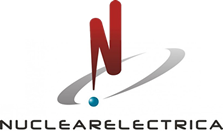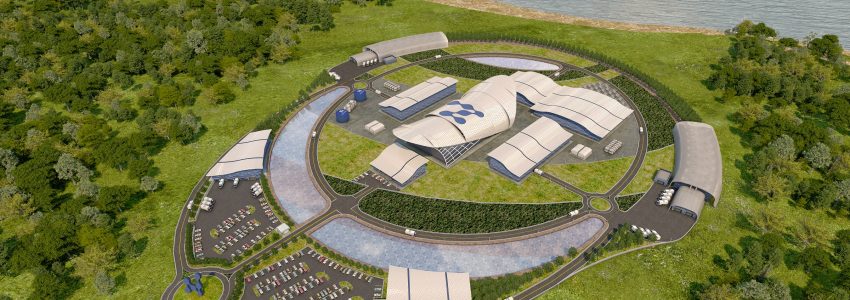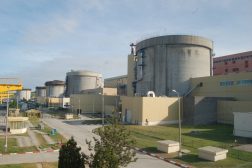Press Release
SN Nuclearelectrica SA has requested the first IAEA SEED (Site and External Events Design) review to assess the process for selecting the site of Europe’s first SMR
Bucharest, September 16th, 2022
SN Nuclearelectrica SA informs that it has requested International Atomic Energy Agency (IAEA) to conduct a Site and External Events Design (SEED) review mission in order to assess the process that was followed in choosing the first small modular reactors (SMR) site in Doicesti, Dambovita county, Romania.
With the purpose of having a very safe and robust SMR project in Romania, SN Nuclearelectrica SA has requested the IAEA SEED mission, an objective, independent, expert assessment of the selection process for the SMR site, in Doicesti Romania.
The three-day IAEA SEED mission, held at the end of August 2022, assessed how Romania conducted the process for the site selection of the SMR against IAEA safety standards including potential impacts to a site from external events, such as tsunamis, earthquakes, and floods etc. The mission team comprised three experts from Germany, Turkey and the United Kingdom.
SEED missions assist IAEA Member States at different stages in the development of a nuclear power programme, including reviewing site selection, site assessment and design of structures, systems and components, taking into consideration site specific external and internal potential hazards.
“We invited IAEA SEED mission because it is a priority for us to build in Romania a state-of-art SMR project, in full compliance with the highest safety standards as we have done in the 25 years we have operated the Cernavoda NPP.” said Cosmin Ghita, Nuclearelectrica CEO. “With the continued support of the IAEA, our experience in siting and building our first SMR can be used by other countries considering building SMRs. SNN is ready to share our experience on strategic and technical aspects of SMR deployment projects.”
“This comprehensive review will provide assurances to the Romanian public and beyond about the SMR site selection,” said Paolo Contri, Team Leader for the review and Section Head for External Events in the IAEA Department of Nuclear Safety and Security. “The recommendations made will help Romania to prepare for the construction of the SMR, by making sure that potential issues associated with site safety are carefully considered early in the process and that alternative sites are available in the event that the selected site does not meet the requirements on the basis of the detailed site characterization. It is important that potential external hazards are identified early to allow for adequate consideration and assessments of protective measures that may be necessary for the defense in depth approach.”
The team appreciated the effort spent by SNN to conduct an objective, feasible and safety-oriented site selection process in Romania. The site selection process is documented in a preliminary SNN report, which will be followed by the FEED study (Preliminary Front-End Engineering and Design (FEED) study), with a limited amount of additional work needed on sensitivity analysis and collection of confirmatory data, as suggested in the SEED mission report, together with detailed recommendations on the minimisation of the project risks.
Some recommendations were provided by the team to support the optimisation of the site selection process, which are currently being already implemented by SNN. In particular, the IAEA team recommended that:
- All data be collected in a summary site selection report, according to the recommendations issued in IAEA Safety Guide SSG-35, to provide traceable support for later decisions and site evaluation phases.
- A suitable graded approach be applied for the specific technology selected for the SMR to be deployed to meet overall safety objectives. Guidelines on the IAEA approach to grading were provided.
- Possible additional data collection phase for the selection process – through limited extra investigation and monitoring – be implemented for the preferred sites, as back-up solutions, focussed on the most discriminating selection criteria.
Romania informed the IAEA that further in-depth assessments of the Doicești site are to be conducted in the upcoming period and that are actively addressing the recommendations of the IAEA SEED mission to support this work.
We remind you that based on the NuScale-Nuclearelectrica Agreement to deploy NuScale SMR technology in Romania by the end of this decade and on the 1,2-million-dollar grant awarded by USTDA, Nuclearelectrica has completed the potential sites related assessment and has selected Doicesti, Dambovita as the preferred site. Further in-depth assessments of the site are to be conducted in the upcoming period that will be supported by the recommendations of the IAEA SEED mission. In June 2022, Nuclearelectrica received a grant of USD 14 million from the United States Trade and Development Agency (USTDA) to prepare a Preliminary Front-End Engineering and Design study (FEED) related to the construction of a small modular reactor in Doicesti.
About SN Nuclearelectrica SA
The National Company “Nuclearelectrica” S.A. is the national electricity, heat and nuclear fuel producing company, operating under the authority of the Ministry of Energy, with the State holding 82.49% of the shares and other shareholders, 17.50%, after the company’s listing on the stock exchange in 2013.
CNE Cernavoda Branch, operates Units 1 and 2 of the Nucleaelectrive Power Plant at Cernavoda, and FCN Pitesti Branch is the nuclear fuel plant.
Nuclearelectrica plays a major role at national level, contributing more than 18% of the total national energy production with nuclear energy. Nuclear energy also plays a key role in achieving decarbonisation targets and ensuring the energy transition to a carbon-free economy, currently contributing 33% of total CO2-free energy production, and after strategic investment projects, this contribution will increase to 66% by 2030.
By 2030, nuclear energy will provide about 35% of the consumption needs by operating 4 CANDU nuclear units, avoid the release of 20,000,000 million tonnes of CO2/year, indirectly create about 19,000 jobs in the domestic supply chain, contribute to the development of education and research in nuclear and related fields. Through its investment projects, the Unit 1 Refurbishment, Units 3 and 4 Project, the Deterioration Plant, Cobalt 60 production, worth about 9 billion Euro, SNN becomes a pillar of decarbonisation while generating a multiple micro- and macro-economic development effect. SNN achieves these projects by raising a new generation of nuclear engineers, by retaining and training young people in Romania, by exploiting their potential.
www.nuclearelectrica.ro










